Collecting autographs
Interested in certificates whose primary value resides in autographs?
Autograph collecting is a separate hobby that overlaps the stock and bond hobby. Many celebrities signed certificates, either as stockholders, bondholders, or as individuals connected with railroad companies. Autographs can be important for their historical significance and their speculative possibilities.

Highly affordable signature of Erastus Corning, founder and first president of the New York Central Rail Road.
Newcomers often share the misconception that autographs represent excellent opportunities to "get rich quick." A warning is in order.
Yes, a person can sometimes stumble into the autograph hobby and win. Like most other hobbies, autograph collecting normally requires careful research. It normally requires a clear understanding of the market. Without both (and without a modicum of luck), speculation in autographs represents an opportunity to waste money.
Be cautious when you first start collecting autographs! If you see an autograph for sale, and you do not already know who that person was, that is a sign you need to do research. Never buy an autograph until you know whose signature you are buying and why YOU need to own it.
There is a pecking order among autographs in historical importance, enduring fame, and price. Do not let a seller convince you that a signature belongs in a higher category just because they want to sell it.
Top-tier autographs
My records are incomplete because there is simply no way to track all sales across the globe. However, based on my records, only six rail-related signatures have attracted auction results in excess of $10,000:
|
| Celebrity |
Price |
Sale |
Date |
| Andrew Carnegie |
$78,400 |
Smythe 194 |
Jan 21, 2000 |
| James Fisk |
$26,834 |
Smythe 182 |
Jan 22, 1999 |
| Cornelius "Commodore" Vanderbilt |
$28,700 |
Tschöpe 46 |
Nov 4, 2000 |
| Jay Cooke |
$19,100 |
Tschöpe 45 |
May 13, 2000 |
| Meyer Guggenheim |
$11,000 |
Tschöpe 45 |
May 13, 2000 |
| Jay Gould * |
$13,800 |
Smythe 229 |
Jun 13, 2000 |
| Leland Stanford |
$12,300 |
Tschöpe 46 |
Nov 4, 2000 |
* appeared on 1868 Erie stock certificate as president; appearance on Missouri Kansas & Texas Railway certificates usually sell in the range of $150 to $300; prices are usually higher on certificates of companies other than the MK&T.
High-class autographs
The prices above were "high-water marks.' All of those signatures have sold for much less than $10,000 depending on the certificates on which they appeared and conditions of their signatures.
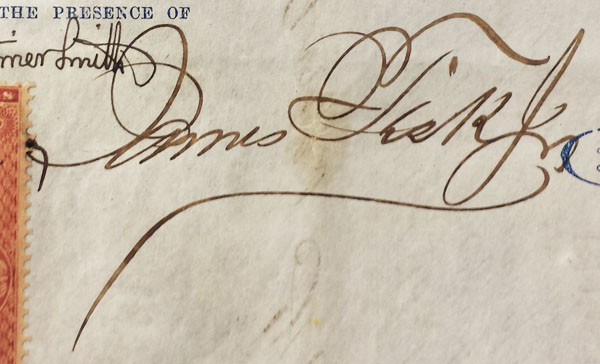
Highly sought-after signature of James Fisk, famous Erie Railroad robber baron and cohort of Jay Gould, murdered in 1872 in the Grand Central Hotel in New York
There are a number of celebrities whose signatures are highly-sought after on railroad certificates, but are more numerous than the previous group. These are signatures that commonly sell for more than $1,000. Some have occasionally broken the $5,000 barrier. Price usually depends on the certificates on which they appear. Celebrities in this class include Andrew Mellon, Charles D. Lanier, Daniel Drew, Gen. Pierre Beauregard, Nathan Bedford Forrest, Hetty Green, Henry Frick, John D. Rockefeller, Marshall Field, Otto Mears, Thomas Edison, William Palmer, and William Cody.
At this level of collecting, speculative value is normally in the autographs and prices of underlying certificates. Historical associations can radically alter collector interest.
Autographs of medium importance
Down the ladder of importance are signatures of prominent railroaders (Jay Gould, Harriman, Huntington, etc.), William Henry Vanderbilt, important industrialists (Morgan, DuPont, Mellon), politicians (Fillmore), and prominent Civil War military figures (Burnside.)
Those people were important Americans, but collectors usually pay $200 to $500 for their signatures. Their popularity is somewhat fickle. They are in a different class than the previous group. Like the previous group, their signatures are worth more than the certificates they grace, but the rarity of underlying certificates does affect values.
Among this group, a signature frequently seen is Jay Gould's on Missouri Kansas & Texas Railway certificates. While prices occasionally dip lower, MK&T certificates with his signature usually attracts bids in the $150 to $300 range. HOWEVER, that same signature in association with the Erie Railway is highly sought after and much more expensive.
Autographs of less importance
In less demand are signatures of minor figures. This group includes autographs from people like Cassatt, Clews, Depew, Grow, and Scott. These people were important to their companies. Many were well known, even famous, in their time. Still, they had limited impact on the nation as a whole. This group also includes most Civil War generals.
At this level of collecting, you can discern the values of autographs separate from the values of certificates. Expect to pay $5 to $100 for autographs from this group plus the value of certificates on which they appear. Buy autographs from this group carefully. Always consider possible resale. Remember, just because you are enticed to buy, does not guarantee similar interest in the future. When you consider autographs in this class, try to buy autographs that appear on scarcer certificates and make sure signatures are legible and have minimal cancellations.
Locally-important autographs
The most unpredictable group of autographs are those of locally-important figures. These are figures who were important in one city, county, or state, but who may not have been well-known elsewhere. Such autographs can attract high bids in one auction and go unsold in the next. Autographs of this nature are the realm of specialists.
Fame and autograph demand
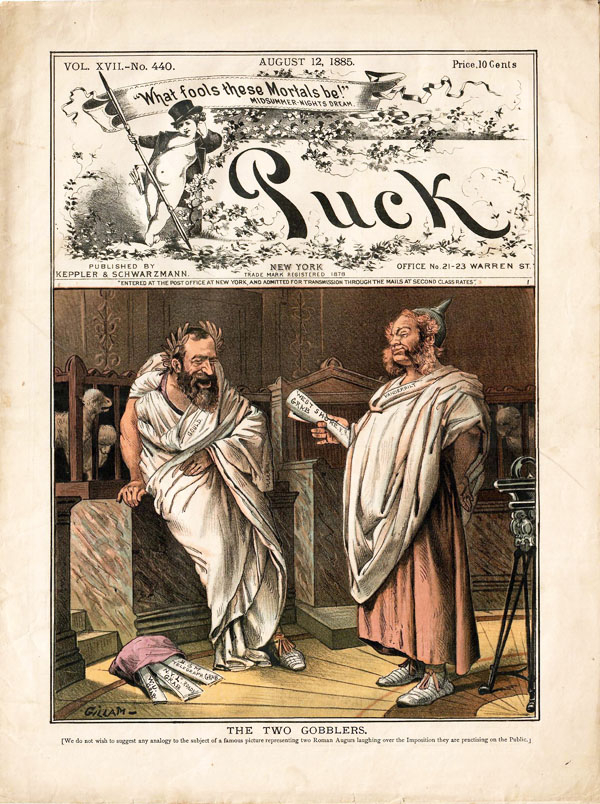 Jay Gould (left) and William Henry Vanderbilt, the two most famous New York millionaires in the mid-1880s appeared repeatedly on the Covers of Puck and Judge magazines
Jay Gould (left) and William Henry Vanderbilt, the two most famous New York millionaires in the mid-1880s appeared repeatedly on the Covers of Puck and Judge magazines
Generally, the richer and more influential the individual, the greater the collector demand.
Autographs from last century’s top-tier millionaires are usually in high demand. Autographs from heirs and offspring usually attract much less interest and lower prices. Signatures from celebrity spouses and children are usually collected by specialists.
Unless individuals were notorious, rich, or both, autographs of company officers are seldom sought after. Autographs from persons of pure celebrity (movie stars, composers, sports figures) are valued roughly in comparison with their enduring fame. The perceived value of autographs from politicians, military figures, judges, crooks, and other notables roughly track their degree of national impact.
Understand the role of sellers
Collectors MUST understand that the role of sellers is to make every signature sound important. Never mind whether those autographs are dreadfully common. Never mind that the signatories were not especially important. Do your own research and you will see that many so-called "autographs" show little if any year-to-year price appreciation. Do not fall for huckster hype. Not all autographs are valuable.
This project is about collecting stocks and bonds, not autographs. Consequently, For the reasons mentioned above, I DO NOT LIST every possible autograph that dealers may have listed or enthusiasts may have collected.. Appearances of autographs in a handful of catalogs, dealer lists, and especially eBay sales are NOT sufficient reasons for inclusion.
What exactly is an autograph?
For the purposes of this catalog, an autograph is:
- A hand-signed signature, usually in ink, by the person whose name appears.
An autograph is NOT:
- a printed or rubber stamped facsimile signature.
- a signature signed by a mechanical device (Autopen or Signa-Signer).
- a signature signed by anyone (a surrogate or "secretarial" signer) other than the person named.
Issued to, but not signed by...
You will see sporadic references in this project to certificates that were issued to famous people, although the celebrities never signed them. Such certificates are not autographed. Nonetheless, they carry famous names and they sometimes attract auction bids above ordinary certificates.
Signed for companies
Many investors became so successful or notorious that they became celebrities in their own rights. Famous investors include people like Henry Clews, Daniel Drew, J.P. Morgan, E.H. Harriman, Jay Cooke, and so forth. Many of those investors formed their own brokerages and carried investments for others in their company accounts. During the normal course of buying and selling securities, brokerages hand-signed thousands of certificates. Some of those endorsements represent the signatures of famous investors, but the VAST majority do not.
You will occasionally see certificates issued to corporate names such as "Henry Clews & Co" or "Morgan & Co." on railroad certificates. They are often found hand-signed on the back as "_________ & Co." Those endorsements are RARELY represent the signatures of the principals. When buying "autographs" of celebrities who supposedly signed for companies, be sure sellers supply proof of autograph authenticities. Since most brokerage certificates were signed by clerks, be sure YOU know what legitimate autographs of celebrities are supposed to look like BEFORE YOU BUY.
As an aside, I want to relate a story of one of my more advanced and reliable contributors. He suddenly left the hobby in utter disappointment. He had bought a certificate with one such supposed autograph. He discovered the autograph was merely a secretarial signature and requested his money back. The seller refused. Be alert and know what a celebrity autograph is supposed to look like BEFORE YOU BUY.
Secretarial signatures
Pens used for autographs
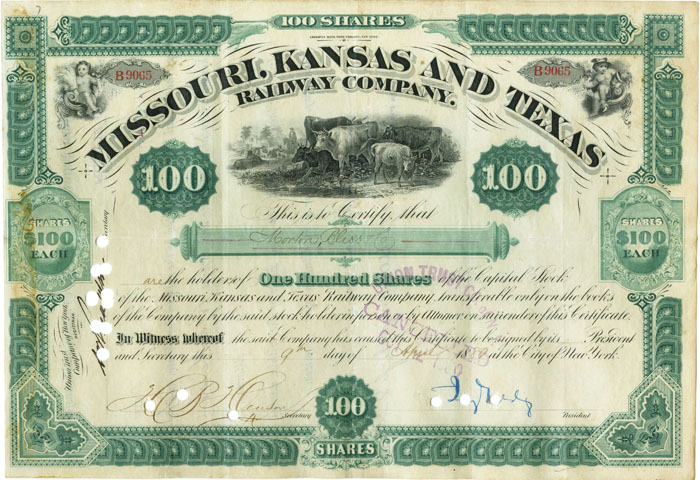 Because of his enduring notoriety, Jay Gould's signature retains notable prices in spite of its appearances on large numbers of 1880 Missouri Kansas & Texas Railway certificates.
Because of his enduring notoriety, Jay Gould's signature retains notable prices in spite of its appearances on large numbers of 1880 Missouri Kansas & Texas Railway certificates.
Prior to the 1940s, almost all stocks and bonds were signed by hand with quill and later, steel nib fountain pens. At the time of signing, ink was usually black or bluish black. Over time, many of those kinds of ink aged to a brown color. Many old autographs show a brown halo caused by migration of the liquid agent (usually linseed oil) that held black pigment (usually lamp black.)
Signatures signed in ball point pen started appearing in the 1950s. You will occasionally find much older certificates that have been signed with ball-point pens at later dates. While no purposeful malice or deception may have been intended, such certificates frequently represent low-quality fake signatures, usually written by children.
The earliest ball point pen patent was issued in 1888, but the modern ball-point pen was not refined enough for general use until about 1935. Even then, those early devices experienced serious problems with ink flow. In practice, ball point pens were not sold in large quantities until the Christmas season of 1945. Certificates signed before that time should be examined carefully and those signed before 1935 have an elevated probability of being non-genuine.
Facsimile autographs
Facsimile signatures were usually printed by offset or intaglio presses, although they were sometimes applied by rubber stamps. While a few facsimile signatures have proven problematic, there are four good methods to differentiate facsimiles from genuine autographs.
- One sure way to tell the difference is to flip certificates over. Fountain pen ink from genuine autographs sometimes soaked into the paper. Printed facsimile ink sits on top of the paper and never soaked through.
- Real autographed pen stroke sometimes dented paper and the evidence can sometimes be seen from the backs of certificates.
- Another method is to look closely where pen strokes cross. If the junction of the two strokes is exactly the same shade of black as the surrounding pen strokes, you are probably dealing with a facsimile. (Experiment with both fountain pens and ball-point pens to see how the ink becomes heavier where pen strokes cross.)
- Facsimile signatures are always the same shade of black as the printed portions of certificates.
Facsimile signatures are common on recent stocks and bonds, but it is hard to pinpoint exactly when they first appeared. The New York Central used pre-printed officers’ autographs in the 1940s and thereafter. The earliest recorded facsimile signature in the database is currently attributed to a New York Central specimen (NEW-530-Ss-65) from 1914. Facsimile autographs are seen on railroad annual passes as early as the mid-1880s.
There is no easy way to discriminate between Autopen signatures and genuine handwritten signatures. Generally, you need several certificates for comparison. If several signatures are identical in flow and appearance, you have a mechanically-made signature. If the signatures vary from example to example, you probably have genuine signatures. (Notable exceptions are the signatures of the U.S. Presidents where several different auto-signing machines were/are used concurrently.)
Authenticity
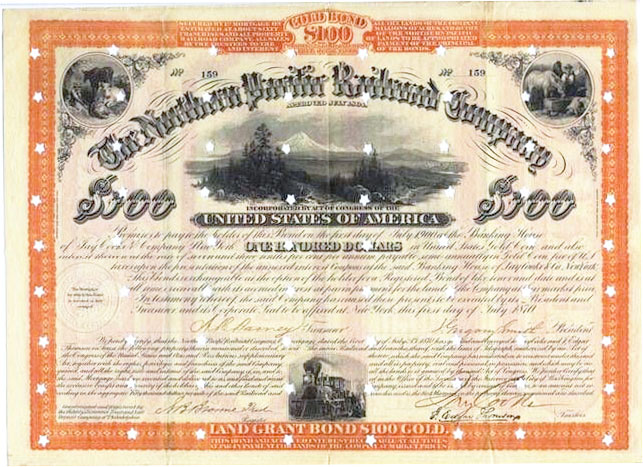 Auktionhaus Reinhild Tschöpe sold this Northern Pacific certificate signed by Jay Cooke for a record high price in 2000.
Auktionhaus Reinhild Tschöpe sold this Northern Pacific certificate signed by Jay Cooke for a record high price in 2000.
Authenticity is a serious issue with autographs. Fortunately, the engraving on stocks and bonds is usually so complex, and certificates are still so cheap, that counterfeiting whole documents makes little sense. However, there is nothing to prevent forgers from buying unissued certificates and adding fake signatures. Theoretically, they can also remove worthless signatures from issued certificates and substitute forgeries of valuable autographs.
As of 2025, stock and bond autograph forgeries have proven very rare. If prices rise significantly, that might change. Protect yourself as much as possible by buying autographs from reputable, established dealers who unequivocally guarantee their products. For valuable signatures, seek expert authentication from one or more third-party appraisers completely separate from sellers.
Think you have some special sixth sense that allows you to detect an autograph forgery? Think again. i advise all my to digest:
- Salamander: the story of the Mormon forgery murders by Linda Sillitoe and Allen Roberts
Salamander was originally published in 1988 and is still in print as of 2025. If you are buying any autographed stocks or bonds for speculative reasons, I genuinely BEG you to read this book.
Autograph pricing
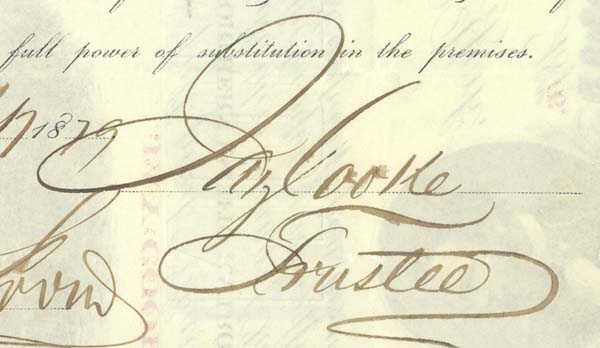
1879 autograph of Jay Cooke
The so-called value of autographs depends on one thing – how important buyers think an autograph should be. One buyer may be enamored with the tenacity of John Casement as he drove the Union Pacific westward across the continent. Another buyer might wonder, "Who cares?"
In other words, the perceived value of every autograph is personal.
The values of autographs presented in this catalog originate from prices realized at auctions of stocks and bonds. In most cases, auction prices represent competition between two or more bidders. I absolutely do not consult autograph "price guides."
Look before you leap
Buy autographs cautiously, especially when you are first starting. Study all aspects of autograph collecting before you invest. Prices are cyclic. Autograph prices CAN AND DO FALL! Financial returns are never guaranteed.
Think about resale
Whether sensible or not, autograph collecting is too often with investing. Consequently, when you collect autographs, you should always keep an eye on potential resale.
Never buy an autograph before you assess its future value. Be as dispassionate as humanly possible. Ask yourself whether future collectors will think a particular signature as desirable as you do today. Autographs from Commodore Vanderbilt and J.P. Morgan are easy. But what about autographs from Henry Clews and Chauncey Depew? Yes, some collectors will probably always want those autographs. But at what price?
Uncontrollable events affect values
Random events affect people’s impressions about the importance of specific autographs. For example, consider 1869 bonds from the Selma Marion & Memphis Railroad. All were signed by Confederate hero Nathan Bedford Forrest.
In 1989, bonds with his signature routinely sold for $150 to $250. Then came Public Television’s broadcast of Ken Burn’s Civil War series in 1990. Within months, dealers in a wide range of hobbies noticed an unprecedented interest in every kind of collectible related to the Civil War. By 1992, Selma Memphis & Marion bonds were selling for as much as $900. Auction prices topped $1,100 by 1994. They peaked in the $2,500 to $3,000 range and have since dropped substantially. They are currently selling in the range of $1000 to $1500 with some even lower.
Outside events can also lower values and salability of autographs. Signatures of World War I personalities were in high demand during the 1920s and 1930s. After World War II, interest in World War I autographs dropped significantly. Prices are still low considering their age and historical significance.
The numbers
I get numerous requests to include additional people among those already cataloged in this railroad scripophily project. To be included, I generally include people of enduring fame, either on a national or international stage or among recognized railroad personalities. Those of international fame, are commonly known in both North America, Europe, and elsewhere. Celebrities of "national" fame are usually very well known among citizens of their own countries, although not necessarily cross border. Only a few names of railroad personalities are known generally, but many are known commonly among collectors of railroad certificates.
Once a personality falls outside those categories, they become questionable for inclusion in this project. In fact, if one looks at the numbers of people who might possibly be suggested for inclusion, importances of their separate roles normally fade. Not meaning to ignore people massively important in Canada, Mexico, Cuba, and elsewhere in the Central America and the Caribbean, here are the types of Americans who are often suggested for inclusion (specific numbers wewre estimates current to the end of 2025):
- 952-965 men served as generals during the Civil War
- 1,367±10 men were awarded brevet general status during and after the Civil War, often posthumously
- 11,257 people have served as United States Representatives (plus more in territories)
- 2,017 people have served as United States Senators
- 116 people have seved as Supreme Court Justices
- approx 2,400 people have served as Governors of States and Territories
- 4,000 to 5,000 people were considered Millionaires before 1900
- well over 20,000,000 have served as mayors, judges, and other public positions
- untold thousands of entertainers, sports figures, writers, etc.
- more than 50,000 people were railroad presidents
- prominent investors and famous brokers (?)
In other words, I think a person really needs to stand out from the crowd to be considered a "celebrity" and whose signature might be worthy of increased collectible value.